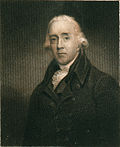Following Nelson's victory at Trafalgar in 1805, Sir John Duckworth left the blockade of Cadiz and pursued a French squadron to the Caribbean, where he defeated it off San Domingo on the 6 February 1806. With six ships of the line and two frigates he was lying off St Kitts, watering and refitting his squadron, when he heard on that three French ships of the line were making for San Domingo. A force of nine French ships were found at anchor in San Domingo Roads, whence they slipped their cables and made sail in a westerly direction, forming a line of battle close inshore. The British closed in on them in two lines to cut them off.
The action began when 'Superb', 74 guns, under the command of Sir John Duckworth, fired at the French 'Alexandre', 80 guns. In the action that followed the French ships' Alexandre', Brave', 74 guns, and 'Jupiter', 74 guns, were taken while the 'Diomede', 72 guns, and the huge 'Imperial', 120 guns ran themselves ashore and were wrecked. The three French frigates, 'Felicite', 36 guns, 'Comete', 36 guns and 'Diligente', 18 guns escaped. The 'Imperial', in port-bow view is in the right centre foreground of the painting, engaged to port with the 'Superb', nearly bow on. The 'Imperial's' main topmast is falling. To the right and beyond is the partly dismasted 'Northumberland', 74 guns, in starboard-quarter view. Beyond her in the extreme right background is the British 'Spencer', 74 guns, stern on, and in the background between the 'Superb 'and 'Northumberland' is the dismasted 'Brave.' In the centre middle ground, in port-bow view and partly masked by the 'Imperial 'is the 'Diomede', being engaged to starboard by the British 'Canopus', 80 guns, in starboard-bow view. Astern of her the stern half of the British 'Atlas', 74 guns, is visible, followed by the 'Agamemnon', 64 guns, in starboard-bow view, with the 'Alexandre' in starboard-quarter view in the distance. In the extreme left of the picture the British 'Donegal', 74 guns, in starboard-bow view is engaging the French 'Jupiter', 74 guns, to port. There is a fresh breeze and a choppy sea.
This painting was a large-scale commission for Admiral Charles Middleton, Lord Barham, and records an event which took place while he was First Lord of the Admiralty, 1805-06. Pocock made many preparatory sketches for the commission giving full details of this action, in accordance with his usual practice of ensuring accuracy.
Pocock was born and brought up in Bristol, went to sea at the age of 17 and rose to command several merchant ships. Although he only took up painting as a profession in his early forties, he became extremely successful, receiving commissions from naval commanders anxious to have accurate portrayals of actions and ships. By the age of 80, Pocock had recorded nearly forty years of maritime history, demonstrating a meticulous understanding of shipping and rigging with close attention to detail.








